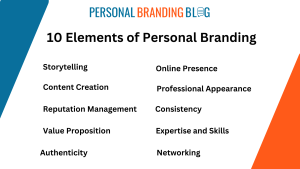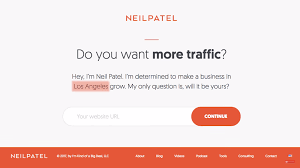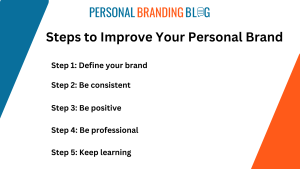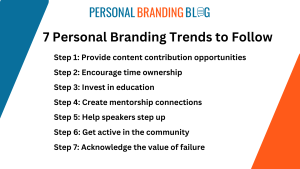What is Personal Branding
Personal branding is the practice of marketing and promoting oneself as a brand. It involves the conscious and strategic effort to create and maintain a specific image or reputation for an individual. Just as companies establish brands in the marketplace, individuals can do the same to distinguish themselves personally and professionally.


Personal branding encompasses a variety of elements, including:
- Online Presence: Managing your presence on social media platforms, websites, and blogs to reflect your personal and professional identity.
- Authenticity: Being genuine and true to your values, beliefs, and skills. Authenticity is a key component of personal branding.
- Consistency: Maintaining a consistent image and message across various platforms and interactions.
- Professional Appearance: Dressing and presenting oneself in a manner that aligns with the personal brand’s image.
- Expertise and Skills: Demonstrating expertise and skills in your chosen field, including education, experience, and certifications.
- Networking: Building and nurturing relationships with others in your industry or field to enhance your brand.
- Storytelling: Crafting and sharing your personal and professional story to connect with your audience more personally.
- Value Proposition: Communicating what you can offer to others, whether it’s through your work, knowledge, or services.
- Reputation Management: Being aware of how others perceive you and actively working to maintain a positive reputation.
- Content Creation: Sharing relevant content, such as articles, videos, or podcasts, that aligns with your personal brand and provides value to your audience.
Why is Personal Branding Important?
Your personal brand makes you unique and sets you apart from the competition. It is the sum of everything people know about you, including your skills, experiences, and reputation. Personal branding can give you a significant advantage in today’s increasingly competitive job market.
By articulating your unique value proposition right personal brand, you can make yourself more attractive to potential employers and clients. In addition, creating a strong personal brand can help you stand out in the crowd and build a loyal following of customers and supporters.
Ultimately, personal branding is all about taking control of your career and setting yourself up for success. By investing the time and effort to develop a strong personal brand, you will be well on your way to achieving your professional goals.
Six Personal Branding Statement Examples
First Statement: “Do You Want More Traffic?” by Neil Patel


In the present world, every business owner and website wants to generate more traffic. Neil is one of the world’s best internet marketers and is renowned for his SEO and traffic-generating abilities. So, Neil’s knowledge and veteran experience regarding SEO is surely a gold mine. He knows clearly how to establish more traffic on the website. His statement works overwhelmingly because he has a sturdy reputation regarding his capabilities.
Second Statement: “Be a Unicorn in a Sea of Donkeys.” by Larry Kim


If you cannot find a good statement relating to your personal connection or brand directly, then go for something very different and unique like Larry Kim. Larry is a search marketing expert and Mobile Monkey and Wordstream founder. He provided the above statement, inspiring millions of people to be different from the typical crowd.
Third Statement: “Empowering Ridiculously Good Marketing” by Ann Handley


The above simple sentence with only four words is enough to convey the message you want to share with the people if you have the necessary qualifications and capabilities. That’s what Ann Handley did. She is a pioneer in the world of digital marketing and assists other marketers in scaling up their marketing enterprises to generate remarkable outcomes. The terms are very unique, yet they speak about her capabilities. Moreover, statements containing ridiculous and empowering words catch the attention of the people.
Fourth Statement: “Sophisticated. Authentic. Timeless.” by Sofia Crokos

Sofia Crokos is a popular event organizer who has planned several celebrity weddings, like Robert Downey Jr’s. The statement tells us about her motivation: she targets sophistication, authenticity, and timelessness. Three different words aligned together provide the perfect tagline for her professional capabilities. The preceding statement allows you to envision a classy, sophisticated global event for yourself, which is only possible because of Sofia Crokos’s high qualifications.
Fifth Statement: “Create Less Content. (It’ll be fine! I promise!) by Brittany Berger

The above cheerful statement by Brittany Berger is very different from most taglines. The “It’ll be fine, and I promise part” to help set it apart by making it personal and relatable. Furthermore, she encourages people to create less content, which she claims she will use efficiently. So, for efficient content organization, Brittany Berger has gained prominence.
Sixth Statement: “I Believe in You. Now You Must Believe in Yourself.” by Dave Nelson
Dave Nelson is a professional certified fitness trainer who says he believes in people and will try to inspire them to believe in themselves. He struggled against obesity in past, and that’s why he can relate to people with the same problem. His statement might not be unique, but this simple yet compelling statement ideally shares his brand’s goals. While training, he will surely inspire people and help them achieve their fitness goals.
Five Steps to Improving Your Personal Branding


Here are five steps that you can take to improve your personal branding:
Step 1) Define Your Brand:
Before you can improve your own personal brand, you need to take some time to define it. What are your core values? What strengths do you want to highlight? How do you want to be perceived by others? These are all important questions to answer before you start working on building your brand. Once you have a clear idea of what you want your brand to represent, you can start taking steps to make it a reality.
Step 2) Be Consistent:
One of the most critical aspects of successful personal branding is consistency. You must ensure that your behavior, online presence, and communications reflect the same message. If you’re inconsistent, people will be confused about what your brand stands for, making it difficult for them to connect with you. So take some time to think about the image you want to project and then work on consistency in everything you do.
Step 3) Be Positive:
Your personal brand should be built on positivity and optimism. No one wants to consistently connect with someone negatively, so make sure your interactions with others are positive. This doesn’t mean that you have to be fake or always happy, but it does mean being mindful of the energy you’re putting out into the world. People will respond positively to genuine and upbeat people, so focus on radiating those qualities.
Step 4) Be Professional:
Another important element of effective personal brand branding is professionalism. This doesn’t mean that you have to be boring or stuffy, but it does mean being respectful and presenting yourself in a way that is appropriate for the situation. Don’t use slang or profanity if you’re interacting with someone online. If you’re meeting someone for a business lunch, dress appropriately and mind your manners. Always be conscious of how your behavior is affecting your personal brand.
Step 5) Keep Learning:
Finally, remember that personal branding is an ongoing process. You’re never done improving your brand – there’s always room for growth. So keep learning and expanding your skillset. The more knowledgeable and well-rounded you are self-branding, the better positioned you’ll be to build a strong personal brand.
Personal Branding Mistakes to Avoid
1. You haven’t set a goal.
Think about what you want to be known for — or recruited for. It feels nice to boast about your many skills in a tight labor market. After all, you never know whether you’ll get hired for your expertise in video editing, blogging, or baking a delicious rum cake.
Trying to be all things to everyone is like applying for 1,000 jobs. Focus on a certain issue and target audience.
Not sure where to focus?
Examine your professional highlights for a link. You might want to sell yourself as a charming emcee for weddings or other special occasions. Maybe you’ve always been organized and want to develop your wedding planning side company.
The internet has a lot of noise. Maybe you can foresee future interior design trends and get a following on Pinterest.
Decide who you want to be first, then promote yourself. The right people will find you as soon as you can articulate your specialty online and in-person and exhibit your expertise.
2. Doubtful branding applies to you.
Personal branding may help you progress your career, whether a high school senior or a C-suite executive. Personal branding is all about advertising and distinguishing oneself online.
It’s about controlling your online shop to achieve your goals.
If you are a high school senior, you may want to get into prestigious colleges. College students must show their skills when applying for internships or summer jobs.
A C-suite executive may wish to develop their business, obtain more customers, or move into a different industry.
Whatever you do, your online presence may help or harm you. Don’t think that personal branding doesn’t apply to you.
3. You’re not providing accurate data.
You’ve pitched a tent on LinkedIn and researched Twitter, but you’re not getting any traction. Which branding errors are you making?
Overpromotion?
Not every status post should include the VIP you met or your new job. The “rule of thirds” works well on your social media accounts. In other words, a third of your posts may be for selling your “brand.”
Underpromoting?
You’re one of the few that realize not everyone enjoys your daily meal. Be cautious not to hold back on social accounts due to modesty, shyness, or privacy concerns. Don’t be that person who publishes anything — from too-revealing swimwear images to off-color jokey talks with your BFFs. What is social media’s sweet spot? Therefore, a mix of professional and personal interests, with a dash of your dazzling personality — all without being too intimate.
Aim for the share value.
Share interesting articles, ideas, and resources you’ve discovered online. Your friends and followers will immediately know you as a helper.
4. Affirming a false identity.
Whenever we first meet someone new, we usually want to show our best selves. Maybe our apartment is cleaner than usual. Maybe our jobs are more exciting and remarkable than they were last week. Therefore, this strategy may help you capture someone’s attention and build a deeper bond. To keep a relationship going, you may have to become someone you are not.
Personal branding is a little like courting.
Putting your best foot forward online can help you catch the attention of institutions, jobs, and new clientele. But be careful not to overdo it. Nobody likes a liar in their life. Therefore, personal branding and relationships in the offline world need authenticity. However, avoid masquerading as someone you’re not.
5. You lack a website.
Your website can best manage your message since it will dominate a Google search for your name. Consider your website as a showcase of your skills. No need for a slew of frills. By this time, it’s usually too late. There is a lot of ground to cover.
7 Personal Branding Trends to Follow


Follow these best practices to make personal branding examples help employees cultivate strong personal brands:
1. Provide content contribution opportunities.
Do you publish all your company’s content under your name — or, worse, the brand’s name? If so, you’re not just missing opportunities to give brand voice and help employees grow their brands — you’re also missing out on better audience engagement. Consumers prefer content from people over brands, so give employees opportunities to express themselves and attach their names to their work. Offering different voices and perspectives will increase your readership and cultivate long-term interest.
2. Encourage time ownership.
Don’t micromanage employees or give them simple lists of tasks to accomplish. Instead, teach them calendar management or download top calendar apps, and allow workers to use their time more wisely. You hired smart people for a reason, and the more opportunities they have to explore their innovative sides, the more confidence they’ll gain. That’s good for them, good for your own company too, and a good look for anyone thinking about joining your team.
3. Invest in education.
The digital world requires diverse skill sets. To stand out from the crowd, workers today need to know about more than just the tasks in their job descriptions. Invest in employee training opportunities, such as conferences or subscriptions to online educational resources. Ambitious team members will use their newfound knowledge to innovate and explore for your company.
4. Create mentorship connections.
Despite the popularity of new communication tools, young people at work prefer face-to-face communication over emails and IMs. Provide opportunities for more experienced employees to mentor younger ones. The “old” hands can grow their management chops, while the younger staffers can get more hands-on experience under the guidance of people who know the industry well. Both sides get to accelerate their growth while helping each other.
5. Help speakers step up.
Speaking engagements provide valuable connections and visibility for your brand; your employees want in on the action. Instead of hogging the limelight yourself, help your employees get speaking gigs at trade shows, schools, association meetings, and conferences. When employees suffer from stage fright, help them overcome their fears by letting them consistently create content and publish short videos on the company website. The content will help you now, while the experience will help them later.
6. Get active in the community.
Modern audiences prefer brands that give back. Employees, too, want to work for companies that strive for more than profits. Get involved in community efforts, and let employees lead the way. Use your network to connect with local leaders, then step back and let team members handle the specifics. Your brand will look good, your community will benefit, and your employees will add to their growing prestige.
7. Acknowledge the value of failure.
No one grows without failure. Implement company policies that encourage smart risks. Never punish employees who take a risk and miss; your team members need to know they can explore without fear of retribution. When your employees know you have their back, they’ll feel more confident about their ability to innovate — a vital component of any solid, successful personal brand.
The more you invest in your brand identity and employees’ brands, the more your company’s reputation will spread. Eventually, your industry will be filled with thought leaders who all point to your company as a catalyst for their growth. Take advantage of every opportunity to help your employees expand their influence — it will pay dividends for you both.
Advice From Experts
Here are the 8 rules of #personalbranding 3.0: https://t.co/axEzlhDY8B
— William Arruda (@careerblastme) September 27, 2023
Personal branding tip:
It's not about projecting an image, but reflecting your genuine self.
Authenticity wins every time.
— Thomas (@TomWritesForYou) September 26, 2023
I built a 15K+ following on Twitter and LinkedIn over the past 2 years. But you can do it much faster. How?
By not following one popular piece of advice about personal branding- "Choose a niche. Be narrow."
Don't be narrow. Don't pick a niche. Be You.
— Sushrut Mishra (@SushrutKM) September 26, 2023
Branding has been very effective in my journey.
Today,
I will be sharing my personal branding playbook for $0.
Make sure to repost for more enthusiasts to read and gain value.
Let's dive into it:
⇨ Pick a personal brand name
The short form of Denise is Dee.
InfluencerDee… pic.twitter.com/hbeawGkGCB
— Denise 🇳🇬 (@InfluencerDee) September 19, 2023
Conclusion
As we look into the future, it’s evident that personal branding will continue to play an increasingly vital role in the lives of those who recognize its potential. In 2023 and beyond, remember that your personal brand is a story in progress that you can shape. By being deliberate, authentic, and purposeful in your personal branding strategy efforts, you can navigate the complex landscape of the modern world with clarity and confidence, leaving a lasting and positive impression on all those you encounter.













